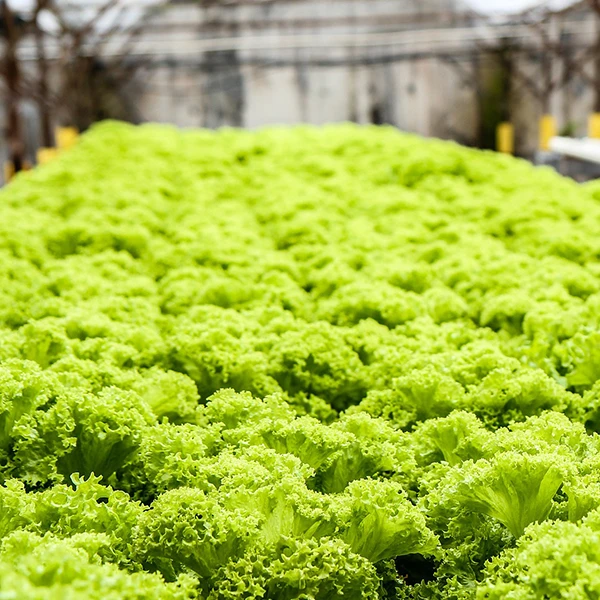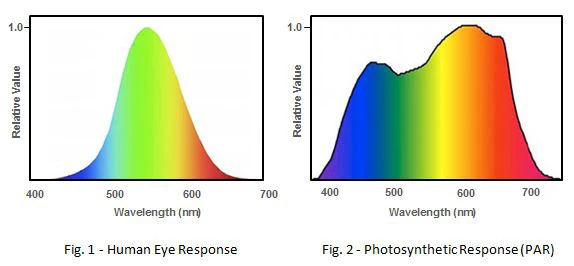แสงสว่างพืชสวน

แสงเป็นปัจจัยด้านสิ่งแวดล้อมที่สำคัญสำหรับการเจริญเติบโตของพืชโดยขับเคลื่อนการสังเคราะห์ด้วยแสง (กระบวนการแปลงพลังงานแสงเป็นพลังงานเคมีในพืช) การสร้างสัณฐานวิทยา (กระบวนการพัฒนาพืชที่ควบคุมด้วยแสง) และช่วงแสง (การรับรู้แสงและความมืดของพืชที่ส่งผลต่อกำหนดการออกดอก) การเจริญเติบโตและพัฒนาการของพืชได้รับอิทธิพลอย่างมากจากทั้งปริมาณและคุณภาพของแสง
ปริมาณ
ลักซ์และลูเมนเป็นหน่วยโฟโตเมตริกและใช้ในการวัดความเข้มและปริมาณแสงที่มองเห็นทั้งหมดที่ปล่อยออกมาจากแหล่งกำเนิดแสง ใช้เพื่อกำหนดระดับแสงสูงสุดและการสูญเสียการส่งผ่านแสงภายในเรือนกระจก
รูปที่ 1 แสดงการตอบสนองของดวงตามนุษย์ต่อความยาวคลื่นต่างๆ ของ แสงที่มองเห็นได้ (400 นาโนเมตรถึง 700 นาโนเมตร)ในขณะที่รูปที่ 2 แสดงการตอบสนองของการสังเคราะห์แสงของพืช ซึ่งควบคุมโดยรังสีแอคทีฟสังเคราะห์ด้วยแสง (PAR) (PAR คือช่วงของพืชที่มีความยาวคลื่น สามารถใช้ในกระบวนการสังเคราะห์แสงได้) เนื่องจากการตอบสนองทางสายตาของมนุษย์ไม่สัมพันธ์กับการตอบสนองของการสังเคราะห์แสง การวัด PAR หรือที่เรียกว่าการวัดควอนตัม จึงใช้สำหรับการวิเคราะห์เชิงปริมาณของช่วงแสง และแสดงค่าเป็นหน่วยของโฟตอนฟลักซ์ (โมล m−2s−1) หรือฟลักซ์พลังงาน (W/m 2 )

คุณภาพ
มีตัวรับแสงในพืชหลายประเภท และตัวรับแสงแต่ละประเภทรองรับช่วงความยาวคลื่นเฉพาะ คุณภาพแสงส่วนใหญ่รับรู้ได้จากตัวรับแสงเหล่านี้
คลอโรฟิลล์ เป็นเซลล์รับแสงที่สำคัญที่สุดในระหว่างการสังเคราะห์ด้วยแสง ในขณะที่ไฟโตโครม คริปโตโครม และโฟโตโทรปินเป็นเซลล์รับแสงที่สำคัญที่สุดในระหว่างการสร้างสัณฐานวิทยา ไฟโตโครมมีหน้าที่รับผิดชอบต่อแสงสีแดง cryptochrome จดจำแสงสีน้ำเงิน เขียว และ UV-A ในขณะที่โฟโตโทรปินรับรู้แสงสีน้ำเงิน
ไฟ LED เป็นไฟเสริมสำหรับเรือนกระจก
ก่อนที่จะมี LED ที่มีสเปกตรัมเฉพาะ การค้นหาว่าพืชความยาวคลื่นที่เหมาะสมที่สุดที่จำเป็นสำหรับการสังเคราะห์ด้วยแสงถือเป็นเรื่องท้าทาย แหล่งกำเนิดแสงแบบดั้งเดิม เช่น เมทัลฮาไลด์หรือหลอดโซเดียมความดันสูง จำเป็นต้องมีตัวกรองที่ไม่มีประสิทธิภาพสำหรับนักปลูกพืชเพื่อศึกษาผลกระทบของสเปกตรัมต่างๆ ต่อพืช อย่างไรก็ตาม ด้วยไฟ LED ทำให้ตอนนี้สามารถค้นพบสเปกตรัมที่เหมาะสมที่สุดซึ่งจำเป็นสำหรับการสังเคราะห์ด้วยแสง และนำไปใช้กับไฟสำหรับการเจริญเติบโต (แหล่งกำเนิดแสงเทียมที่ออกแบบมาเพื่อกระตุ้นการเจริญเติบโตของพืช) ซึ่งจำเป็นในทุกขั้นตอนของการเจริญเติบโตและการพัฒนาของพืชผล
ในการวัดปริมาณพลังงานที่มีอยู่ในแหล่งกำเนิดแสงสำหรับการสังเคราะห์ด้วยแสงและโฟโตมอร์โฟเจเนซิส คุณ สามารถใช้เครื่องวัดสเปกตรัม หรือ เครื่องวัดการฉายรังสีสเปกตรัม ได้ เครื่องมือเหล่านี้ให้ข้อมูลสเปกตรัมของแหล่งกำเนิดแสง และมีประโยชน์สำหรับการศึกษาและการออกแบบการจัดแสงสำหรับการสังเคราะห์ด้วยแสงและการสร้างสัณฐานวิทยาด้วยแสง
สำหรับข้อมูลเพิ่มเติมเกี่ยวกับเครื่องมือวัดแสง กรุณาเยี่ยมชมเว็บไซต์ของ Konica Minolta ที่ https://sensing.konicaminolta.asia/th/applications/light-measurement/ หรือติดต่อเราที่ +65 6895 8685 หรือส่งอีเมลถึงเราที่ ssg@gcp.konicaminoltaดอทคอม
เกี่ยวกับผู้แต่ง: Garie Xu
Garie Xu เป็นวิศวกรฝ่ายขายของ Konica Minolta Sensing Singapore Pte Ltd. สำเร็จการศึกษาจากพื้นหลังด้านวิศวกรรมการผลิต โดยเขาทำงานด้านการขาย การสัมมนา การฝึกอบรม และการฝึกสอนในด้านการจัดการแสงและสีเป็นหลัก ด้วยประสบการณ์ 3 ปีในอุตสาหกรรมน้ำมันและก๊าซ และ 2 ปีในโคนิก้า มินอลต้า เขากำลังจัดหาโซลูชั่นให้กับการใช้งานทางอุตสาหกรรมมากมาย นอกจากนี้ เขายังได้จัดสัมมนาและเวิร์คช็อปเพื่อให้ความรู้แก่อุตสาหกรรมเกี่ยวกับเทคโนโลยีเครื่องมือวัดและวิทยาศาสตร์สีอีกด้วย

